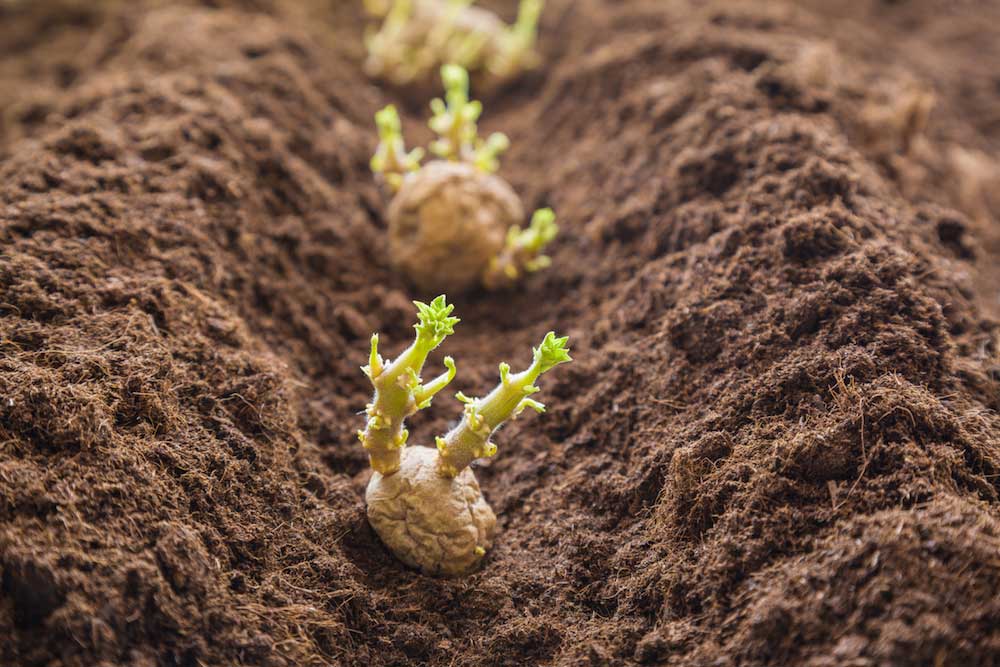When it comes to growing potatoes, one of the most common questions gardeners ask is: “How deep should I plant my potatoes?” It might seem like a simple detail, but the depth you plant your seed potatoes can directly influence how well they grow, how many potatoes you harvest, and how healthy your plants remain throughout the season.
In this guide, we’ll explore the ideal depth for planting potatoes, factors that affect planting depth, different planting techniques, and useful tips for achieving the best yields in your garden. Whether you’re a beginner or a seasoned gardener, this article will give you the information you need to plant potatoes like a pro.

Why Planting Depth Matters for Potatoes
Potatoes grow underground on stems known as stolons. These stolons sprout from the seed potato and form tubers (the potatoes we eat) under the soil. If you plant too shallowly, your tubers might be exposed to sunlight, causing them to turn green and develop a toxin called solanine, which is harmful when consumed. On the other hand, planting too deeply can slow growth or even cause the seed potato to rot if the soil stays too wet and cold.
The right planting depth ensures:
- Proper tuber formation
- Healthy root development
- Protection from sunlight
- Adequate soil warmth and moisture levels
Ideal Planting Depth for Potatoes
The recommended planting depth for potatoes depends on the variety you’re growing, the soil type, and your chosen planting method. Generally, most potatoes are planted at a depth of 4 to 6 inches (10 to 15 cm). Here’s a simple guideline:
- Small seed potatoes (egg-sized): 4 inches deep
- Medium to large seed potatoes: 5–6 inches deep
Spacing is also essential. Space seed potatoes about 12 inches apart in rows spaced 24 to 36 inches apart to give the plants ample room to grow.

Factors That Influence Planting Depth
Several variables affect how deep you should plant your potatoes. Let’s take a closer look at the main ones:
1. Soil Type
- Light, sandy soils warm up quickly in spring, making them ideal for slightly deeper planting — up to 6 inches.
- Heavy, clay soils hold moisture longer and warm up slower, so plant slightly shallower (about 4 inches) to prevent rot and promote early growth.
2. Climate
- In cooler, wet climates, shallower planting is better to avoid rot and allow quicker sprouting.
- In hotter regions, slightly deeper planting can help protect tubers from heat and keep soil moisture consistent.
3. Planting Method
Different planting styles (like trenching, hilling, or container planting) require adjustments to planting depth, which we’ll detail shortly.

Popular Potato Planting Methods and Their Depth Requirements
1. Traditional Trench Method
One of the oldest and most reliable ways to grow potatoes is the trench method.
- Dig a trench 4 to 6 inches deep.
- Place seed potatoes cut-side down (eyes facing up).
- Cover with 2–4 inches of soil initially.
- As the plants grow, gradually mound soil around them (called hilling) to cover stems and encourage more tuber production.
Why it works: This method protects developing potatoes from sunlight and provides loose soil for tuber expansion.
2. Hilling Method
Hilling is often combined with trench planting.
- After planting seed potatoes at 4 inches deep, let the shoots grow to 6–8 inches tall.
- Then, mound soil up around the stems, leaving just the top few leaves exposed.
- Repeat hilling every couple of weeks as plants grow.
Why it works: Hilling keeps tubers covered and increases yields by stimulating additional stolon growth.
3. Raised Bed or Container Planting
Perfect for gardeners with limited space or poor soil.
- Plant seed potatoes 4–5 inches deep in loose, well-draining soil.
- As plants grow, add soil or mulch around stems, just like hilling.
- Make sure containers are at least 18 inches deep for best results.
Why it works: Raised beds and containers warm quickly and allow you to control soil conditions easily.
4. Straw Mulch Method
An easy, low-maintenance option.
- Place seed potatoes on the soil surface or in a shallow trench 1–2 inches deep.
- Cover with 4–6 inches of clean straw.
- Add more straw as plants grow to maintain coverage.
Why it works: Straw keeps tubers covered, retains moisture, and reduces the need for weeding.
When to Plant Potatoes
Timing is just as important as depth. Potatoes are a cool-season crop. The ideal planting time is 2–4 weeks before your area’s last expected frost date when soil temperatures reach 45–50°F (7–10°C).
If soil is too cold or wet, seed potatoes can rot before sprouting.

Pro Tips for Planting Potatoes Successfully
- Chit your seed potatoes: Before planting, allow seed potatoes to sprout by placing them in a cool, bright spot indoors for 2–3 weeks. This jump-starts growth.
- Avoid fresh manure: It encourages scab disease. Use well-aged compost or balanced fertilizer instead.
- Water consistently: Keep soil evenly moist, especially during tuber formation, but avoid waterlogging.
- Practice crop rotation: Don’t plant potatoes in the same spot more than once every 3–4 years to prevent disease buildup.
- Harvest carefully: Wait until plants flower and die back for main crops. Use a garden fork to gently lift tubers without damaging them.
Common Mistakes to Avoid
- Planting too shallowly: Exposes tubers to light, causing greening and bitterness.
- Overcrowding plants: Reduces airflow and increases disease risk.
- Using poor-quality seed potatoes: Always buy certified disease-free seed potatoes for reliable harvests.
- Skipping hilling or mulching: Exposes growing tubers and limits yield potential.
Final Thoughts
So, how deep should you plant potatoes?
The sweet spot is 4 to 6 inches deep, depending on your soil type, climate, and planting method. Remember to space them well, practice hilling or mulching as they grow, and provide consistent care.
By following these guidelines and avoiding common pitfalls, you’ll enjoy a healthy, productive potato harvest — whether you grow them in the ground, a raised bed, or a container on your patio.
Happy planting and may your garden be filled with plump, flavorful potatoes this season!





Leave A Comment